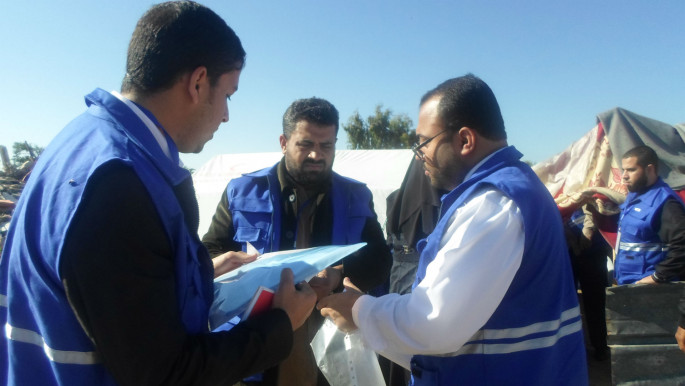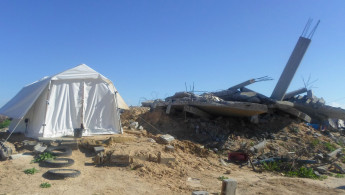Do it yourself in besieged Gaza
It's been a cold winter in Gaza. Earlier this month, snowstorm Huda blustered in. To a population forgotten by the world and left desolate by war and destruction, it was brutal. Fatal in some cases.
But Gaza has learned to adapt and to act. Under siege for eight years, Gazans have had to rely on themselves, whether that is by powering cars with cooking gas, smuggling goods through tunnels, or helping those poorer than themselves.
| We need to put smiles back on the faces of the children. - Sarah Noafa, volunteer |
"We will not leave the poor alone," says Munir Tabash, a volunteer with the Palestinian Independent Commission for Youth Rights.
The 22-year-old says that there is no government support, so volunteers have to help the refugees themselves.
"So far we have shifted 47 families," he says proudly. "Honestly, the situation of a lot of people is terrible. I am surprised they can survive in such conditions."
The youth group was founded by Raed al-Ottol, an architect from Gaza, after Israel's 2014 assault which killed 2,200 Palestinians and left more than 100,000 homeless.
"I just opened a group on Facebook and started collecting money from people and recruiting volunteers. It was very simple," he says.
Despite the Strip's renowned poverty, most of the funding for the group has come from inside Gaza. "We just ask people to donate and then they call me and say, 'Raed, I will give you 500 shekels,' or 1,000," says Ottol. "Now I have collected about $10,000 from inside Gaza."
He says that his decision to set up the group came after his dismissal from the Hamas-affiliated Islamic University of Gaza after criticising the authorities.
"No one stood beside me when I got fired. It opened my eyes to the problems we have here in Gaza - we need to stand up for each other."
Now Ottol taps into the passion and energy of hundreds of young Gazans. Every day from 8am until 5pm they go out in teams to find flats for homeless Palestinians, and even pay for their own travel expenses.
| Unprotected and cold: Snowstorm Huda claims lives among displaced. Read more |
Sarah Noafa is a volunteer with the group. "I heard about the group from a friend and I joined straight away," she said. "We need to put smiles back on the faces of the children."
The group moves displaced families staying in shelters unsuitable for winter conditions into empty flats. The group does this by creating links with local landlords to house the families for two months, until the coldest weather passes.
The urgency of their cause was highlighted by the deaths of one man and three children during the recent snowstorm.
Juhor-a-dik is a farming community close to the border with Israel that has been left completely ravaged by war. There is not a house left standing. Families huddle together in makeshift shelters of wood and corrugated iron, or even in simple tents.
Brothers Mahmoud and Nahid al-Khatib have lived in the area since 1985, when they bought land to farm. But their homes have been destroyed by Israeli shells and tank bulldozers.
They and their families, 20 people in total, were living in a tin shack of 25sq/m with no running water or electricity.
But with the help of the volunteers, the families found a flat in Bureij refugee camp, close to their children's school.
Chris Somerville, a relief worker, says farmers near the buffer zone face a tough future, or none at all.
"The vast majority of the damage to farms... was in the buffer zone. Now there is a de facto 80cm crop height limit. It's hard for farmers to reinvest in this area - there's no security and they can't afford to waste their money."
A devstated community
Mahmoud al-Khatib planted 360 olive trees at his farm in Juhor-a-dik, but these were destroyed by the Israeli army.
"I also kept 26 goats and they were killed. But I will not leave this area, it's my land and I will return to build my house again," he says.
Finding raw materials for home-building is a difficult task in Gaza, due to the ongoing Israeli siege. But the farmer hopes to realise his dream soon.
According to the charity group Oxfam, the flow of vital building materials into Gaza is now one third of what it was before the war, and just four percent of pre-blockade levels.
In the meantime, while the UN has offered support - known as "the transitional shelter cash assistance" - to about 9,000 refugee families to move to rented accommodation, many, such as the Khatib family, have fallen through the net.
"Most of the families we helped said no one had come to offer assistance. They are disappointed and we are too," says Munir.
 |
|
| Raed al-Ottol, centre, founder of PYCIR [Alice Gray] |
Robert Turner, the head of UNRWA operations in Gaza, says the situation will get worse before it gets better.
"To date, almost $80m in payments have been made by UNRWA to families with damaged homes. However, by the end of January, UNRWA will run out of money for repair and rental subsidies."
Turner says that the effect will be disastrous for the families of the 96,000 homes damaged or destroyed during the most recent Israeli assaults.
It appears that reconstruction will be left to the Gazans, who will need all their guile and ingenuity.
"We need to build using local materials," Ottol says. "But there are a number of challenges. We thought about using mud bricks. We can bring the machinery to make them, with the volunteers, but there is a cultural problem. People won't accept to live permanently in houses like this."
He says that another problem is that land is expensive in the densely populated coastal strip.
"People need to build a lot of floors to accommodate their families, so they build vertically," he said. "They don't have space otherwise."
Although mud brick structures have been built up to eleven stories high in Yemen, such as in Shibam, there is not the knowledge of how to do this in Gaza, and besides, these buildings require constant maintenance.
The architect is always looking for solutions to Gaza's housing problems, and believes that by using concrete support blocks, more levels can be built on these mud brick homes.
With more than 1,300 volunteers to hand, and despite the challenges, he remains optimistic: "There is always a solution."



